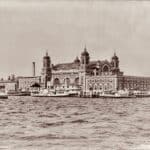

Ellis Island was America’s largest immigration station between 1892 and 1954, processing as many as 12 million immigrants arriving in search of a better life. It is estimated that nearly 40% of all Americans can trace at least one ancestor back to the famous Island.
History
Before Ellis Island opened, individual states handled immigration into the United States. Castle Garden was New York’s immigration station from 1855 to 1890 and processed over 8 million immigrants arriving by ship, mostly from Northern and Western Europe.
As it became clear a larger facility was needed, President Benjamin Harrison designated Ellis Island to be the site of the first Federal immigration station. The new facility opened on January 1, 1892 but burned down in 1897, along with immigration records dating back to 1855. Three years later, a new fireproof facility was built.
Arrival
Not everyone arriving by boat into New York Harbor had to go through Ellis Island. First and second class passengers could bypass the island as the thought was that if they could afford a luxury ticket, they could afford to support themselves and therefore would not become a public burden. Third class passengers were treated differently. These immigrants, traveling in crowded conditions in the belly of steamships, were sent directly to Ellis Island upon arrival.

Once there, they were cross examined with 29 questions and inspected by doctors for any noticeable health problems. If there were no concerns, they spent between 2-5 hours being processed through. Those with significant ailments or questionable papers, however, were either sent back to their country of origin or held in the island’s hospital. Ellis Island was often referred to as “The Island of Tears” or “Heartbreak Island” because of those refused entry after their difficult voyage,
Between 1892 and 1914, approximately 10 million immigrants passed through the immigration station. While it was first thought the facility would handle up to 5,000 people per day, numbers reached as high as 10,000. The peak year, 1907, saw approximately 1.25 million immigrants pass through.
See immigrants arriving in this 1903 footage: ‘Ellis Island Immigrants Disembarking’.
Limiting Immigration
As the United States entered World War I, immigration decreased. There was growing sentiment among the politically powerful to limit immigration and barriers were put into place: a literacy test requirement was introduced in 1917 and quotas were instituted in 1921 and 1924. From 1925 to its closing in 1954, only 2.3 million immigrants passed through the Island. In 1954, the island ceased to be an immigration processing center.
National Monument
President Lyndon Johnson, in 1965, declared Ellis Island part of the Statue of Liberty National Monument. It was opened to the public in 1976 but closed in 1984 for major restorations, the largest historic restoration in U.S. history. In 1990, the Main Building was reopened as the Ellis Island Immigration Museum and is now visited by up to 2 million people a year.

~ Legacy Videos ~
Give your parent or grandparent the gift of a lifetime by capturing their life story for your family to know!

Here at Family Tree Video we produce Legacy Videos, modern-day memoirs that weave a filmed interview with a parent or grandparent, together with family photos, documents, maps and other memorabilia. The result is a beautiful “moving portrait” capturing your loved onesharing their life story, family history and memories – a gift your family will treasure for generations to come.
To learn more about capturing your parent or grandparent’s stories in a Legacy Video, visit FamilyTreeVideo.com.
Family Tree Video LLC
Legacy Video Production
(312) 402-6406
Susan Saunders
Owner/Producer
Like us on Facebook!
Follow us on Instagram!

Ellis Island

Legacy Videos
Capturing Life Stories & Family History
for Future Generations
~ The Gift of a Lifetime ~

Family Tree Video
Video Biographies ~ Video Memoir ~ Family History Video
Family Documentaries ~ Anniversary Videos
Video Tributes ~ Heirloom Videos
Legacy Video Production
~ Since 2008 ~

